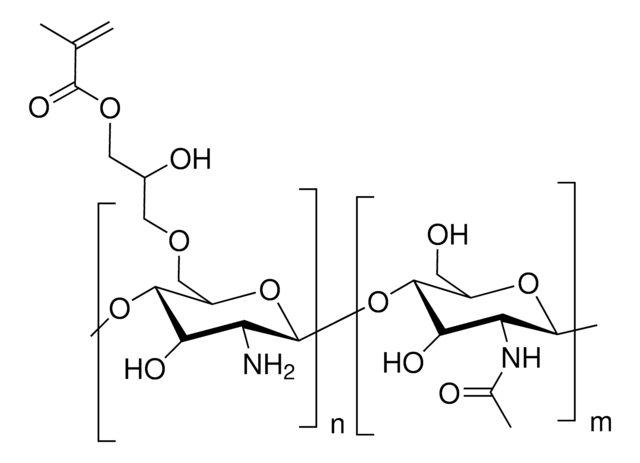推薦產品
一般說明
Gelatin is a natural biopolymer derived from collagen that plays an important role in the biomedical field due to its biocompatibility, biodegradability, and nonimmunogenicity. Acrylate-functionalized gelatin, or gelatin acrylate, can be crosslinked using thiol-Michael click chemistry as well as photochemical crosslinking. It′s properties are very similar to gelatin methacrylate (GelMA). Crosslinked gelatin hydrogels have many applications in tissue engineering and 3D bioprinting.
應用
- Endothelial cell morphogenesis
- Injectable tissue constructs
- Tissue engineering of multiple tissue types including heart tissue (cardiomyocytes), bone tissue (osteogenesis), cartilage tissue (chondrogenesis), and epidermal tissue
- Drug delivery applications including contact lens and dental
特點和優勢
- Photopolymerizable
- Clickable
- Biocompatible
- Biodegradable
相關產品
產品號碼
描述
訂價
儲存類別代碼
11 - Combustible Solids
水污染物質分類(WGK)
WGK 1
閃點(°F)
Not applicable
閃點(°C)
Not applicable
Hongyuan Zhu et al.
Journal of the mechanical behavior of biomedical materials, 88, 160-169 (2018-09-03)
Biocompatible hydrogels with defined mechanical properties are critical to tissue engineering and regenerative medicine. Thiol-acrylate photopolymerized hydrogels have attracted special interest for their degradability and cytocompatibility, and for their tunable mechanical properties through controlling factors that affect reaction kinetics (e.g.
Xin Zhao et al.
Advanced healthcare materials, 5(1), 108-118 (2015-04-17)
Natural hydrogels are promising scaffolds to engineer epidermis. Currently, natural hydrogels used to support epidermal regeneration are mainly collagen- or gelatin-based, which mimic the natural dermal extracellular matrix but often suffer from insufficient and uncontrollable mechanical and degradation properties. In
Kelly M C Tsang et al.
Advanced functional materials, 25(6), 977-986 (2015-09-04)
Hydrogels are often employed as temporary platforms for cell proliferation and tissue organization in vitro. Researchers have incorporated photodegradable moieties into synthetic polymeric hydrogels as a means of achieving spatiotemporal control over material properties. In this study protein-based photodegradable hydrogels
Chaenyung Cha et al.
Biomacromolecules, 15(1), 283-290 (2013-12-19)
Microfabrication technology provides a highly versatile platform for engineering hydrogels used in biomedical applications with high-resolution control and injectability. Herein, we present a strategy of microfluidics-assisted fabrication photo-cross-linkable gelatin microgels, coupled with providing protective silica hydrogel layer on the microgel
Aleksander Skardal et al.
Tissue engineering. Part A, 16(8), 2675-2685 (2010-04-15)
Bioprinting by the codeposition of cells and biomaterials is constrained by the availability of printable materials. Herein we describe a novel macromonomer, a new two-step photocrosslinking strategy, and the use of a simple rapid prototyping system to print a proof-of-concept
Active Filters
我們的科學家團隊在所有研究領域都有豐富的經驗,包括生命科學、材料科學、化學合成、色譜、分析等.
聯絡技術服務






